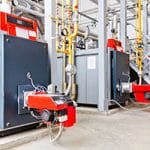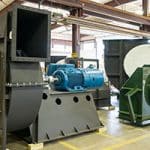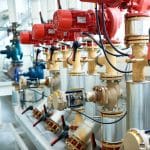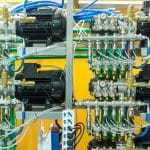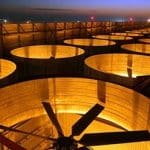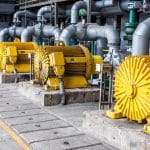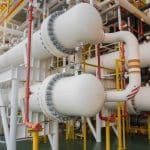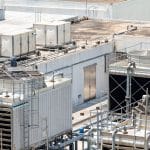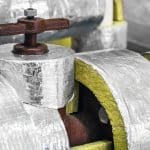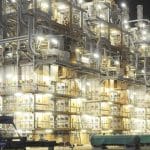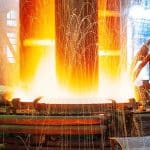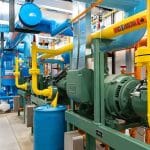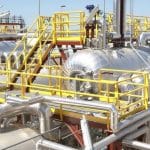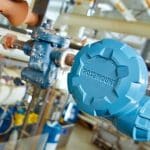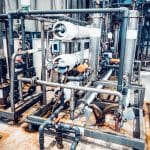The 3 kEys
- Recognizing the costs associated with routine, preventive maintenance, for every maintenance dollar deferred, 4 dollars in cap ex money will eventually need to be spent, prematurely. See FacilitiesNet’s 5 Hidden Costs of Deferring Maintenance.
- Plan your frequency with an eye towards both: 1) the harshness of the environment; and 2) what it would take to align with the operational demands of the system and the risks associated with potential downtime.
- Establish a rigorous preventative maintenance schedule that includes routine cleaning of coils, replacing or cleaning air filters, checking refrigerant levels, and inspecting ductwork.
Industrial HVAC (Heating, Ventilation, and Air Conditioning) systems are the backbone of modern industrial facilities, ensuring optimal environmental conditions for both people and equipment. These systems regulate temperature, maintain air quality, and enhance operational safety and efficiency. However, to keep them functioning at peak performance, a structured and comprehensive maintenance regime is critical.
A well-maintained HVAC system minimizes energy consumption, prevents costly breakdowns, and extends the life of the equipment. This blog explores a robust maintenance plan with tasks categorized by frequency—daily, weekly, monthly, quarterly, and annual—ensuring every aspect of an industrial HVAC system receives the attention it deserves. For additional insights, consider exploring Industrial HVAC Maintenance: Best Practices.
Balancing Maintenance Frequency
While some maintenance tasks demand daily or weekly attention, others can be scheduled less frequently depending on the operating environment. For systems running in high-stress conditions—such as dusty environments or facilities with extreme temperature fluctuations—daily and weekly checks are crucial. These frequent inspections prevent unexpected breakdowns and ensure systems are operating efficiently.
On the other hand, HVAC systems in cleaner, stable environments can often function reliably with biweekly or monthly checks. This allows maintenance teams to focus their efforts on areas of greatest need while optimizing resource allocation. Ultimately, the frequency of maintenance should align with the operational demands of the system and the risks associated with potential downtime. The Importance of Preventive Maintenance for Industrial HVAC provides further perspective on preventive measures.
Daily Insights: Keeping HVAC in Check
Daily maintenance tasks are essential for high-use or mission-critical systems. Regular monitoring helps catch early signs of potential issues and ensures smooth daily operations.
Technicians should begin by inspecting and recording system operating temperatures and pressures. Any unusual noises, vibrations, or odors should be investigated immediately, as they may indicate mechanical wear or component failure. It’s also important to verify that system controls are functioning properly and that airflow around intakes and outlets remains unobstructed.
Checking for visible leaks in refrigerant lines, piping, or ducts is another priority, as undetected leaks can significantly impact performance and efficiency. In high-use environments, daily inspection of air filters for excessive dirt or debris is recommended, along with monitoring energy consumption for unusual spikes that might indicate inefficiency.
Weekly Maintenance: Building on Routine
For systems in demanding environments, weekly maintenance ensures continued reliability. Technicians should inspect and clean air filters if they haven’t been addressed during daily checks. Belts and pulleys should be examined for proper alignment, tension, and wear, while external condenser coils must be cleared of dirt and debris.
Fans and blowers require attention to confirm proper operation, and condensate drains should be inspected for blockages to prevent water damage or mold growth. A quick review of ductwork for visible damage or leaks and adjustments to thermostat settings as needed round out the weekly tasks. Refer to the Guide to Best Practice Maintenance & Operation of HVAC Systems for Energy Efficiency for a detailed checklist.
Monthly Deep Dives
Monthly maintenance dives deeper into the system to maintain efficiency and reliability. Air filters should be replaced, particularly in systems that operate under heavy loads. Cleaning evaporator coils ensures optimal heat exchange, while electrical connections should be inspected and tightened to prevent faults.
Refrigerant levels should be checked and topped up if necessary, adhering to EPA guidelines. Motors and bearings may require lubrication, and dampers should be verified for smooth operation. Technicians should also calibrate system sensors and controls while ensuring that setpoint temperatures are being maintained across all zones. A helpful resource for planning these tasks is the HVAC Preventive Maintenance Schedule Template.
Quarterly Checkpoints
Quarterly maintenance involves a more detailed examination of the HVAC system. This includes deep-cleaning condenser and evaporator coils, inspecting drain pans and piping for bacterial or mold growth, and testing safety controls like high-pressure switches and overload protection.
Airflow measurements across the system help identify inefficiencies, while electronic detectors can be used to check for refrigerant leaks. Combustion areas in heating systems, where applicable, should be inspected and cleaned, and ductwork insulation and seals must be tested for wear or damage. These tasks not only ensure safety but also boost energy efficiency.
Annual Overhauls
Annual maintenance is the most thorough check of the system, focusing on comprehensive performance testing and long-term planning. This includes professional cleaning of the entire system, including ductwork, to improve air quality and efficiency.
Heat exchangers should be tested and cleaned if needed, and worn-out components such as belts and pulleys should be replaced. Electrical systems should undergo load testing to verify stability under full operation, while all controls, thermostats, and actuators are recalibrated for precision.
Auxiliary systems like humidifiers and dehumidifiers should also be tested to confirm proper operation. Reviewing energy consumption data provides insights into efficiency and highlights areas for improvement. Additionally, this is the ideal time to plan for future upgrades or replacements, ensuring the system remains compliant with local codes and industry standards. Preventative Maintenance for Commercial HVAC Equipment offers valuable tips for optimizing annual maintenance efforts.
The Big Finish
A comprehensive maintenance regime is not just about ensuring the reliability of industrial HVAC systems; it’s also a key driver of energy efficiency and cost savings. Properly maintained systems operate more efficiently, consuming less energy while delivering consistent performance. Regular checks and proactive repairs reduce the risk of breakdowns, extending the lifespan of the equipment and minimizing operational disruptions.
Investing in HVAC maintenance isn’t just a cost—it’s a long-term strategy for reliability, efficiency, and sustainability.




